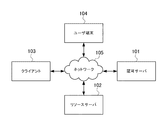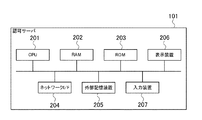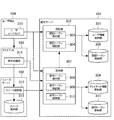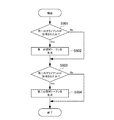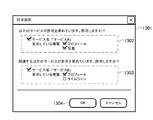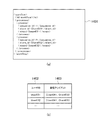JP6815744B2 - Server equipment, systems, information processing methods and programs - Google Patents
Server equipment, systems, information processing methods and programs Download PDFInfo
- Publication number
- JP6815744B2 JP6815744B2 JP2016088411A JP2016088411A JP6815744B2 JP 6815744 B2 JP6815744 B2 JP 6815744B2 JP 2016088411 A JP2016088411 A JP 2016088411A JP 2016088411 A JP2016088411 A JP 2016088411A JP 6815744 B2 JP6815744 B2 JP 6815744B2
- Authority
- JP
- Japan
- Prior art keywords
- client device
- authorization token
- client
- authority
- authorization
- Prior art date
- Legal status (The legal status is an assumption and is not a legal conclusion. Google has not performed a legal analysis and makes no representation as to the accuracy of the status listed.)
- Active
Links
Images
Classifications
-
- H—ELECTRICITY
- H04—ELECTRIC COMMUNICATION TECHNIQUE
- H04L—TRANSMISSION OF DIGITAL INFORMATION, e.g. TELEGRAPHIC COMMUNICATION
- H04L63/00—Network architectures or network communication protocols for network security
- H04L63/10—Network architectures or network communication protocols for network security for controlling access to devices or network resources
-
- G—PHYSICS
- G06—COMPUTING OR CALCULATING; COUNTING
- G06F—ELECTRIC DIGITAL DATA PROCESSING
- G06F21/00—Security arrangements for protecting computers, components thereof, programs or data against unauthorised activity
- G06F21/30—Authentication, i.e. establishing the identity or authorisation of security principals
- G06F21/31—User authentication
- G06F21/41—User authentication where a single sign-on provides access to a plurality of computers
-
- H—ELECTRICITY
- H04—ELECTRIC COMMUNICATION TECHNIQUE
- H04L—TRANSMISSION OF DIGITAL INFORMATION, e.g. TELEGRAPHIC COMMUNICATION
- H04L63/00—Network architectures or network communication protocols for network security
- H04L63/08—Network architectures or network communication protocols for network security for authentication of entities
- H04L63/0815—Network architectures or network communication protocols for network security for authentication of entities providing single-sign-on or federations
-
- H—ELECTRICITY
- H04—ELECTRIC COMMUNICATION TECHNIQUE
- H04L—TRANSMISSION OF DIGITAL INFORMATION, e.g. TELEGRAPHIC COMMUNICATION
- H04L63/00—Network architectures or network communication protocols for network security
- H04L63/10—Network architectures or network communication protocols for network security for controlling access to devices or network resources
- H04L63/102—Entity profiles
-
- H—ELECTRICITY
- H04—ELECTRIC COMMUNICATION TECHNIQUE
- H04L—TRANSMISSION OF DIGITAL INFORMATION, e.g. TELEGRAPHIC COMMUNICATION
- H04L63/00—Network architectures or network communication protocols for network security
- H04L63/20—Network architectures or network communication protocols for network security for managing network security; network security policies in general
-
- G—PHYSICS
- G06—COMPUTING OR CALCULATING; COUNTING
- G06F—ELECTRIC DIGITAL DATA PROCESSING
- G06F2221/00—Indexing scheme relating to security arrangements for protecting computers, components thereof, programs or data against unauthorised activity
- G06F2221/21—Indexing scheme relating to G06F21/00 and subgroups addressing additional information or applications relating to security arrangements for protecting computers, components thereof, programs or data against unauthorised activity
- G06F2221/2145—Inheriting rights or properties, e.g., propagation of permissions or restrictions within a hierarchy
Landscapes
- Engineering & Computer Science (AREA)
- Computer Security & Cryptography (AREA)
- Computer Hardware Design (AREA)
- General Engineering & Computer Science (AREA)
- Computing Systems (AREA)
- Computer Networks & Wireless Communication (AREA)
- Signal Processing (AREA)
- Theoretical Computer Science (AREA)
- Software Systems (AREA)
- Physics & Mathematics (AREA)
- General Physics & Mathematics (AREA)
- Information Transfer Between Computers (AREA)
Description
本発明は、権限を委譲する際のユーザの操作負荷を軽減するサーバ装置、システム、情報処理方法及びプログラムに関する。 The present invention relates to a server device, a system, an information processing method and a program that reduce the operation load of a user when delegating authority.
近年、サーバ装置が提供する様々な機能を、ユーザが使用するユーザ端末からネットワーク経由で利用可能にするサービスが広く展開されている。このようなサービスでは、多くの場合、サービスが保有するリソースへのアクセスをユーザ端末から要求された際に、ユーザID及びパスワード等の認証情報を用いてユーザを認証することを要求する。ユーザはユーザ端末に認証情報を入力する。認証が成功するとサービスから認証トークンが発行される。ユーザ端末は発行された認証トークンを付加して、サービスに処理の実行を要求する。サービスは、認証トークンの示すユーザが有する権限の範囲内で処理の実行を許可する。
また、認証されたユーザが、自身が有する権限をクライアント103に委譲することで、クライアントが権限を獲得して処理を実行するようなことも行われている。ここで、クライアントとは、サービスが保有するリソースを使用するアプリケーションが動作するサーバ装置やモバイル端末等である。クライアントは、権限を委譲される対象としてサービスに登録される。権限を委譲する方法として、例えば、OAuth2.0(非特許文献1)等が広く用いられている。この方法においては、認証されたユーザに、クライアントに対して指定された権限を許可するか否かの判定を依頼する許可画面が提示される。ユーザが許可を選択すると、クライアントにリソースにアクセスするための権限を示す認可トークンが発行される。そのため、ユーザは自分自身の認証情報をクライアントに入力することなく、リソースにアクセスするための権限を委譲することができる。
In recent years, a service that enables various functions provided by a server device to be used from a user terminal used by a user via a network has been widely deployed. In such a service, in many cases, when an access to a resource owned by the service is requested from a user terminal, it is required to authenticate the user by using authentication information such as a user ID and a password. The user inputs the authentication information into the user terminal. If the authentication is successful, the service will issue an authentication token. The user terminal adds the issued authentication token and requests the service to execute the process. The service permits the execution of processing within the authority of the user indicated by the authentication token.
Further, the authenticated user delegates the authority possessed by the user to the
ここで、OAuth2.0のような権限の委譲では、ユーザに対して、どのクライアントにどの権限を許可するかの判定を、クライアントが権限を必要としたタイミングでその都度、依頼することで、リソースのセキュリティを確保している。しかし、クライアントが複数存在する場合、ユーザはクライアントごとに許可を行うという煩雑な操作が必要となり、操作性を損なうことが問題となる。
このような問題を解決する手段として、ユーザの許可操作を簡易化する方法が開示されている。
例えば、特許文献1では、Web情報の所有者であるユーザが設定したポリシー情報を認可サーバに事前に登録し、被譲渡者が使用するクライアントからアクセス要求が発生した場合に、ポリシー情報をもとに認可トークンを発行する。これによって、ユーザが事前に設定した条件で、クライアントに権限を委譲でき、セキュリティを高めつつユーザの操作負荷を軽減できる。
また、特許文献2では、まず、ユーザの許可操作によって、デバイス装置に第一の認可トークンを発行する。次に、第一の認可トークンを使うことによって、デバイス装置にインストールされている各アプリケーションにユーザの許可操作なしで第二の認可トークンを発行する。これによって、デバイス装置にインストールされている複数のアプリケーションが権限委譲の対象となる場合に、ユーザの操作負荷を軽減できる。
これらの技術によって、クライアントが複数存在する場合に、ユーザの許可操作の負荷を軽減できる。
Here, in the delegation of authority such as OAuth2.0, the resource is requested by requesting the user to determine which authority is granted to which client each time the client needs the authority. Security is ensured. However, when there are a plurality of clients, the user needs to perform a complicated operation of permitting each client, which causes a problem of impairing operability.
As a means for solving such a problem, a method for simplifying a user permission operation is disclosed.
For example, in
Further, in
With these technologies, when there are a plurality of clients, the load of the user's permission operation can be reduced.
しかしながら、事前に登録されたポリシー情報に基づいて認可トークンを発行する方法では、ポリシー情報に変更が必要となった場合に対応することが難しい。ポリシー情報に変更が必要な場合とは、例えば、権限委譲の対象となるクライアントが変更された場合や、クライアントに委譲すべき権限の内容が変更された場合等である。
また、デバイス装置に発行された認可トークンに基づいて各アプリケーションに認可トークンを発行する方法では、権限委譲の対象となるアプリケーションごとの権限をユーザに提示して許可の判定を依頼することができない。そのため、権限委譲の対象に応じて適切な権限の許可を判定することが難しい。
本発明は、事前にポリシー情報を登録することなく、権限委譲の対象ごとの権限を考慮したうえで、権限を委譲する際のユーザの操作負荷を軽減する技術を提供することを目的とする。
However, the method of issuing an authorization token based on the policy information registered in advance is difficult to deal with when the policy information needs to be changed. When the policy information needs to be changed, for example, the client to which the authority is delegated is changed, or the content of the authority to be delegated to the client is changed.
Further, in the method of issuing an authorization token to each application based on the authorization token issued to the device device, it is not possible to present the authority of each application to which the authority is delegated to the user and request the determination of permission. Therefore, it is difficult to determine the appropriate permission of authority according to the object of delegation of authority.
An object of the present invention is to provide a technique for reducing the operation load of a user when delegating authority, after considering the authority for each target of delegation of authority without registering policy information in advance.
本発明のサーバ装置は、第一のクライアント装置を権限委譲の対象のクライアント装置と決定した際に、前記第一のクライアント装置と関連する第二のクライアント装置が存在する場合、前記第二のクライアント装置を更に前記権限委譲の対象のクライアント装置と決定する決定手段と、前記決定手段により前記権限委譲の対象のクライアント装置と決定されたクライアント装置に対応する許可画面を生成する生成手段と、前記生成手段により生成された前記許可画面を送信する第1の送信手段と、を有し、前記許可画面には、前記第一のクライアント装置に対して委譲する権限スコープと前記第二のクライアント装置に対して委譲する権限スコープとが含まれ、各権限スコープを許可するか否かをリソースごとに個別に選択可能なオブジェクトが含まれることを特徴とする。 In the server device of the present invention, when the first client device is determined to be the client device to be delegated authority, if the second client device associated with the first client device exists, the second client A determination means for further determining the device as the client device subject to the delegation of authority, a generation means for generating a permission screen corresponding to the client device determined as the client device subject to the delegation of authority by the determination means, and the generation means. possess a first transmission means for transmitting the permission screen generated by means of, on the permission screen, a permission scope to delegate to the first client device to said second client device It is characterized in that it includes an authority scope to be delegated and an object that can individually select whether or not to allow each authority scope for each resource .
本発明によれば、事前にポリシー情報を登録することなく、権限委譲の対象ごとの権限を考慮したうえで、権限を委譲する際のユーザの操作負荷を軽減する技術を提供することができる。 According to the present invention, it is possible to provide a technique for reducing the operation load of a user when delegating authority after considering the authority for each target of delegation of authority without registering policy information in advance.
以下、本発明の実施形態について図面に基づいて説明する。 Hereinafter, embodiments of the present invention will be described with reference to the drawings.
<実施形態1>
まず、本実施形態に係る認可システムの構成例について、図1を用いて説明する。
認可システムは、認可サーバ101、リソースサーバ102、クライアント103、ユーザ端末104から構成される。認可サーバ101、リソースサーバ102、クライアント103、ユーザ端末104は、ネットワーク105を介して互いに通信が可能である。ネットワーク105は、LAN等の同一のネットワークとして接続されていてもよいし、インターネット等の外部ネットワークとして接続されていてもよいし、それらの混合であってもよい。また、認可サーバ101、リソースサーバ102、クライアント103は、それぞれ複数の台数、認可システムに含まれてもよい。
認可サーバ101は、リソースサーバ102が保有するリソースをユーザやクライアント103がアクセスするための権限を管理する。認可サーバ101は、リソースサーバ102にリソースを保有するユーザのユーザ情報を保有している。また、認可サーバ101は、リソースサーバ102が保有しているリソースにアクセスするクライアント103のクライアント情報を保有している。更に、認可サーバ101は、クライアント103からの要求に応じて認可トークンを発行したり、リソースサーバ102からの要求に応じて認可トークンの有効性を検証したりする。ここで、認可トークンとは、認証されたユーザに対して与えられる権限情報、又は認証されたユーザがクライアント103に対して委譲した権限情報が記述されたデータのことである。認可トークンは、例えば、OAuth2.0におけるアクセストークンである。クライアント103は、リソースサーバ102にリソースへのアクセスを要求する際に、認可トークンを取得してリソースアクセス要求と共に送信する。リソースサーバ102は、受信した認可トークンの有効性を検証し、要求の可否を決定する。
リソースサーバ102は、ユーザのリソースを保有する。ここで、リソースとは、Webでアクセス可能なあらゆるデータや処理のことである。データとしては、ユーザのパーソナルデータ、画像データ、文書データ等、様々なものがある。また、リソースサーバ102は、クライアント103からのリソースアクセス要求に応じてリソースを提供する。
クライアント103は、ユーザ端末104からの処理要求に応じて、各種処理を行うアプリケーションが動作するサーバやモバイル端末等である。クライアント103は、権限委譲の対象として認可サーバ101に登録される。クライアント103は、処理を実行する際には、リソースサーバ102に処理に必要なリソースへのアクセスを要求する。また、クライアント103は、リソースサーバ102にリソースへのアクセスを要求するために、認可サーバ101に認可トークンの取得を要求する。
ユーザ端末104は、ユーザが操作する端末であり、パーソナルコンピュータやモバイル端末等である。
<
First, a configuration example of the authorization system according to the present embodiment will be described with reference to FIG.
The authorization system is composed of an
The
The
The
The
次に、本実施形態に係る認可システムを構成する、認可サーバ101のハードウェア構成例について、図2を用いて説明する。なお、リソースサーバ102、クライアント103、ユーザ端末104についても同様の構成である。
認可サーバ101は、CPU201、RAM202、ROM203、ネットワークインタフェース204、外部記憶装置205、表示装置206、入力装置207を少なくとも備えている。
CPU201は、認可サーバ101を構成する各部の動作制御を行うと共に、認可サーバ101が行うものとして後述する各種の処理を実行する主体となる。
RAM202は、データや制御情報を一時的に格納するメモリであり、CPU201が各種の処理を実行する際に用いるワークエリアとなる。
ROM203には、認可サーバ101の固定の動作パラメータやプログラム等が格納される。
ネットワークインタフェース204は、ネットワーク105に接続して通信するための機能を提供するものである。認可サーバ101は、このネットワークインタフェース204によって、外部装置とデータの送受信を行うことができる。
外部記憶装置205は、データを記憶する装置であり、データの読み書きを行うためのI/Oコマンドを受け付けるインタフェースを持つ。外部記憶装置205は、ハードディスクドライブ(HDD)、ソリッドステートドライブ(SSD)、光ディスクドライブ、半導体記憶装置又はその他の記憶装置であってもよい。外部記憶装置205には、プログラムやデータが格納されている。
表示装置206は、例えば、LCD(Liquid Crystal Display)等であり、ユーザに必要な情報を表示する。
入力装置207は、例えば、キーボードやマウス、タッチパネル等であり、ユーザから必要な入力を受け付ける。
Next, a hardware configuration example of the
The
The
The
The
The
The
The
The
認可サーバ101のCPU201が、認可サーバ101のROM203又は外部記憶装置205に記憶されているプログラムに基づき処理を実行することによって、後述する図3の認可サーバ101の機能構成が実現される。また、認可サーバ101のCPU201が、認可サーバ101のROM203又は外部記憶装置205に記憶されているプログラムに基づき処理を実行することによって、後述する図7、図12のうち認可サーバ101のフローチャートの処理が実現される。また、認可サーバ101のCPU201が、認可サーバ101のROM203又は外部記憶装置205に記憶されているプログラムに基づき処理を実行することによって、後述する図10、図11、図13のフローチャートの処理が実現される。
同様にリソースサーバ102のCPU201が、リソースサーバ102のROM203又は外部記憶装置205に記憶されているプログラムに基づき処理を実行することによって、後述する図3のリソースサーバ102の機能構成が実現される。またリソースサーバ102のCPU201が、リソースサーバ102のROM203又は外部記憶装置205に記憶されているプログラムに基づき処理を実行することによって、後述する図6、図12のうちリソースサーバ102のフローチャートの処理が実現される。
同様にユーザ端末104のCPU201が、ユーザ端末104のROM203又は外部記憶装置205に記憶されているプログラムに基づき処理を実行することによって、後述する図3のユーザ端末104の機能構成が実現される。またユーザ端末104のCPU201が、ユーザ端末104のROM203又は外部記憶装置205に記憶されているプログラムに基づき処理を実行することによって、後述する図6、図7のうちユーザ端末104のフローチャートの処理が実現される。
同様にクライアント103のCPU201が、クライアント103のROM203又は外部記憶装置205に記憶されているプログラムに基づき処理を実行することによって、後述する図3のクライアント103の機能構成が実現される。またクライアント103のCPU201が、クライアント103のROM203又は外部記憶装置205に記憶されているプログラムに基づき処理を実行することによって、後述する図6、図7のうちクライアント103のフローチャートの処理が実現される。
When the
Similarly, when the
Similarly, the
Similarly, when the
次に、本実施形態に係る認可システムの機能構成例について、図3を用いて説明する。
認可サーバ101は、認証部302、認可部307、ユーザ情報格納部301、認証トークン格納部305、クライアント情報格納部306、認可トークン格納部311を備える。認証部302は、認証トークン発行部303、認証トークン検証部304を備える。認可部307は、認可トークン発行部308、認可トークン検証部309、認可トークン破棄部310を備える。
ユーザ情報格納部301には、ユーザを認証するためのユーザ情報が格納されている。
ユーザ情報格納部301に格納されているユーザ情報の一例を図4(a)に示す。ユーザID401に関連付けて、パスワード402が格納されている。ユーザID401は、リソースサーバ102にリソースを保有するユーザを一意に識別するIDである。パスワード402は、ユーザが本人であることを検証するための文字列である。ここでは、ユーザを認証するためにパスワード402を用いているが、他の認証情報を用いてもよい。
認証トークン発行部303は、外部装置から認証トークン発行要求を受信した際に、ユーザ情報格納部301に格納されているユーザ情報に基づいてユーザを認証し、認証トークンを発行する。発行された認証トークンは認証トークン格納部305に格納される。
認証トークン格納部305に格納されている認証トークン情報の一例を図5(a)に示す。認証トークンID501に関連付けて、ユーザID502と有効期限503とが格納されている。ユーザID502は、認証されたユーザを表している。有効期限503は、認証トークンの有効期限であり、期限を過ぎた認証トークンは無効となる。
認証トークン検証部304は、認証トークン格納部305に格納されている認証トークン情報に基づいて認証トークンの正当性を検証する。
Next, an example of the functional configuration of the authorization system according to the present embodiment will be described with reference to FIG.
The
User information for authenticating a user is stored in the user
An example of the user information stored in the user
When receiving the authentication token issuance request from the external device, the authentication
FIG. 5A shows an example of the authentication token information stored in the authentication
The authentication
クライアント情報格納部306には、クライアント103が権限を委譲されるために必要なクライアント情報及びクライアント103のグループ情報が格納されている。
クライアント情報格納部306に格納されているクライアント情報の一例を図4(b)に示す。クライアントID403に関連付けて、パスワード404、権限スコープ405、デフォルトグループ406が格納されている。クライアントID403は、クライアント103を一意に識別するIDである。パスワード404は、クライアント103を認証するための文字列である。ここでは、クライアント103を認証するための情報としてパスワードを用いているが、他の認証情報を用いてもよい。権限スコープ405は、クライアント103が有する権限の適用範囲を表している。デフォルトグループ406は、クライアント103が所属するグループの初期設定値を表している。
クライアント情報格納部306に格納されているクライアント103のグループ情報の一例を図4(c)に示す。グループID407に関連付けて、所属クライアント408が格納されている。グループID407は、クライアント103のグループを一意に識別するIDである。所属クライアント408は、そのグループに所属しているクライアント103のクライアントIDを表している。
The client
FIG. 4B shows an example of client information stored in the client
FIG. 4C shows an example of the group information of the
認可トークン発行部308は、外部装置から認可トークン発行要求を受信した際に、認証トークン発行部303によって認証されたユーザによる許可に基づいて、認可トークンを行う。この際、認可トークン発行部308は、クライアント情報格納部306に格納されているクライアント情報に基づいて権限委譲の対象となるクライアント103の有効性を検証する。発行された認可トークンは、認可トークン格納部311に格納される。認可トークン格納部311に格納されている認可トークン情報の一例を図5(b)に示す。認可トークンID504に関連付けて、クライアントID505、権限スコープ506、有効期限507、関連認証トークンID508、関連認可トークンID509が格納されている。クライアントID505は、権限が委譲された、即ち認可トークンが発行されたクライアント103を表している。権限スコープ506は、認可トークンが有する権限の適用範囲を表している。有効期限507は、認可トークンの有効期限であり、期限を過ぎた認可トークンは無効となる。関連認証トークンID508は、権限の委譲を許可したユーザの認証トークンを表している。関連認可トークンID509は、その認可トークンと同時に生成された認可トークンを表している。送信状態510は、その認可トークンが対象となるクライアント103に送信済みであるか否かを表している。
認可トークン検証部309は、外部装置から認可トークン検証要求を受信した際に、認可トークン格納部311に格納されている認可トークン情報に基づいて認可トークンの正当性を検証する。
認可トークン破棄部310は、外部装置から認可トークン破棄要求を受信した際に、認可トークン格納部311に格納されている認可トークンを破棄する。
When the authorization
When the authorization
When the authorization
リソースサーバ102は、リソース提供部312とリソース格納部313とを備える。
リソース格納部313には、ユーザが保有するリソースが格納されている。リソース提供部312は、外部装置からリソース取得要求を受信した際に、リソース格納部313に格納されているリソースを提供する。このとき、リソース提供部312は、リソース取得要求に付加されている認可トークンが、リソースに対する権限を保有しているか否かを、認可サーバの認可トークン検証部309に問い合わせて検証する。
クライアント103は、要求処理部314を備える。
要求処理部314は、ユーザ端末からの処理要求に応じて、リソースサーバ102にリソース提供要求を送信して、処理に必要なリソースを取得する。要求処理部314は、リソース提供要求には、認可サーバの認可トークン発行部308から取得した認可トークンを付与する。
ユーザ端末は、ユーザエージェント315を備える。
ユーザエージェント315は、Webブラウザ等、ユーザがWebサイトにアクセスするための機能を提供する。
The
Resources owned by the user are stored in the
The
The
The user terminal includes a
The
次に、本実施形態に係る認可システムの動作について説明し、併せて、本実施形態に係る認可方法について説明する。
図6は、本実施形態に係る認可システムの情報処理の一例を示すフローチャートである。なお、本実施形態では、クライアント103としてウェブアプリケーションを提供するサーバを想定して記載するが、クライアント103はモバイル端末のアプリケーション等、他の形態であってもよい。
まず、ユーザ端末のユーザエージェント315は、ユーザ操作に応じて、クライアント103に対する処理要求を受け取ると、クライアント103に処理要求を送信する(S601)。クライアント103の要求処理部314は、処理要求を受信する(S602)。要求処理部314は、処理の実行にリソースサーバ102が保有するリソースが必要な場合には、認可サーバから認可トークンを取得する(S603)。認可トークンの取得処理については、図7を用いて後述する。認可トークンが取得できた場合、要求処理部314は、認可トークンを付加したリソース取得要求をリソースサーバ102に送信する(S604)。リソースサーバ102のリソース提供部312は、リソース取得要求を受信する(S605)。リソース提供部312は、リソース提供要求に付加されている認可トークンが有効なものであるか否かを検証する(S605)。認可トークンの検証処理については、図12を用いて後述する。認可トークンが有効なものである場合、リソース提供部312は、リソースをクライアント103に送信する(S608)。クライアント103の要求処理部314は、送信されたリソースを受信する(S608)。要求処理部314は、受信したリソースを使用して処理要求に対応した処理を実行し、処理結果をユーザ端末に送信する(S609)。ユーザ端末のユーザエージェント315は、処理結果を受信し、ユーザ端末の表示装置206に表示することでユーザに提示する(S610)。
Next, the operation of the authorization system according to the present embodiment will be described, and the authorization method according to the present embodiment will also be described.
FIG. 6 is a flowchart showing an example of information processing of the authorization system according to the present embodiment. In this embodiment, the
First, when the
次に、本実施形態に係る認可システムで行われる認可トークンの取得処理について図7を用いて説明する。なお、図7では、OAuth2.0のプロトコルに基づいた処理フローとなっているが、同様の処理フローを備えた他のプロトコルであってもよい。
まず、クライアント103の要求処理部314は、認可サーバ101に認可トークン取得要求を送信する(S701)。認可トークン取得要求は、実際には、ユーザ端末を経由してクライアント103から認可サーバに送信される。
認可トークン取得要求のメッセージの一例を図8(a)に示す。図8(a)は、HTTP(Hypertext Transfer Protocol)のプロトコルに従った構文によってメッセージが形成されている。URL(Uniform Resource Locator)部1201に要求の宛先が指定され、末尾にURLパラメータとして、クライアント103のクライアントIDが指定されている。これによって、認可サーバ101では、どのクライアント103が認可トークン取得要求を行っているのかを特定することができる。また、URLパラメータとして、クライアントのグループIDが指定されている。これによって、認可サーバでは、どのグループのクライアント103に対して一括して許可判定を依頼し、認可トークンを生成するかを特定することができる。ヘッダ部1202には、許可判定の依頼を行うユーザの認証情報が指定されている。
認可サーバ101の認可トークン発行部308は、クライアント103から送信された認可トークン取得要求を受信する(S702)。認可トークン発行部308は、認可トークンを発行するために許可を行うユーザが認証済みか否かを判定する(S703)。認可トークン発行部308は、認可トークン取得要求に認証トークンが付加されているか、付加されている認証トークンが有効かによって認証済みか否かを判定する。認証済みでないと判定した場合(S703においてNo)、認可トークン発行部308は、ユーザに認証を要求するための認証画面をユーザ端末に送信する(S704)。
Next, the acquisition process of the authorization token performed by the authorization system according to the present embodiment will be described with reference to FIG. 7. Although the processing flow is based on the OAuth 2.0 protocol in FIG. 7, another protocol having the same processing flow may be used.
First, the
An example of the authorization token acquisition request message is shown in FIG. 8A. In FIG. 8A, the message is formed by the syntax according to the HTTP (Hypertext Transfer Protocol) protocol. The destination of the request is specified in the URL (Uniform Resource Locator)
The authorization
認証画面の一例を図9(a)に示す。認証画面1101は、ユーザの認証情報(例えば、ユーザID及びパスワード)を入力する領域1102と、入力した認証情報を確定し、認可サーバ101に送信するためのボタン1103とから構成されている。
ユーザ端末のユーザエージェント315は、認可サーバ101から送信された認証画面を受信し、表示装置206に表示する(S705)。ユーザエージェント315は、入力装置207を介してユーザによって入力された認証情報を受け取ると(S706)、認証情報を認可サーバ101に送信する。認可サーバ101の認証トークン発行部303は、認証情報を受信する(S707)。認証トークン発行部303は、受信された認証情報で認証が成功すると、認証トークンを発行する(S708)。認証トークン発行部303は、発行した認証トークンを認可トークン取得要求に付加して、認可トークン発行部308に渡す。すると、認可トークン発行部308は、認証済みのユーザに許可判定を依頼するための許可画面を生成する(S710)。許可画面の生成処理については、図10を用いて後述する。認可トークン発行部308は、生成した許可画面をユーザ端末に送信する(S711)。一方、認証済みであると判定した場合(S703においてYes)、認可トークン発行部308は、認証トークンに関連付けられている送信待ちの認可トークンが存在するか否かを検証する(S709)。送信待ちの認可トークンが存在しない場合(S709においてNo)、認可トークン発行部308は、S710にて同様に許可画面を生成する。ユーザ端末のユーザエージェント315は、認可サーバ101から送信された許可画面を受信し、表示装置206に表示する(S712)。ユーザエージェント315は、入力装置207を介したユーザ操作に応じて、許可指示の入力を受け付けると、許可判定情報を認可サーバ101に送信する(S713)。認可サーバ101の認可トークン発行部308は、許可判定情報を受信する(S714)。認可トークン発行部308は、許可判定情報に基づいて、認可トークンを生成する(S715)。認可トークンの生成処理については、図11を用いて後述する。
An example of the authentication screen is shown in FIG. 9A. The
The
認可トークン発行部308は、生成された認可トークンのうち、認可トークン取得要求で権限委譲の対象となっているクライアント103の認可トークンをクライアント103に送信し、送信状態を"送信済み"にセットする(S716)。一方、送信待ちの認可トークンが存在すると判定した場合(S709においてYes)、認可トークン発行部308は、S716においてその認可トークンを送信し、送信状態を"送信済み"にセットする。クライアント103の要求処理部314は、認可トークンを受信する(S717)。S716からS717までの処理は、実際には、まず一時的認可情報が含まれる認可結果がユーザ端末を経由してクライアント103に送信される。そして、クライアント103は、一時的認可情報を使って認可サーバから認可トークンを取得する。
認可結果のメッセージの一例を図8(b)に示す。図8(b)には、HTTPのレスポンスとしてメッセージが形成されている。ステータス部1203には、認可要求の結果を示すステータスがセットされている。また、ヘッダ部1204には、一時的認可情報が含まれている。一時的認可情報は、クライアント103が認可トークンを取得するために使用される。
Among the generated authorization tokens, the authorization
An example of the authorization result message is shown in FIG. 8 (b). In FIG. 8B, a message is formed as a response of HTTP. A status indicating the result of the authorization request is set in the
一時的認可情報を使った認可トークン取得要求のメッセージの一例を図8(c)に示す。図8(c)は、HTTPのプロトコルに従った構文によってメッセージが形成されている。URL部1205には、要求の宛先が指定されている。ヘッダ部1206には、クライアント103の認証情報が指定されている。これによって、認可サーバ101では、認証が成功したクライアント103に対してのみ、要求の実行を許可することができる。ボディ部1207には、一時的認可情報が指定されている。
クライアント103に送信される認可トークンのメッセージの一例を図8(d)に示す。図8(d)は、HTTPのレスポンスとして、メッセージが形成されている。ステータス部1208には、認可トークン取得要求が成功したことを示すステータスがセットされている。ボディ部1209には、認可トークンと、認可トークンの有効期限等がセットされている。
このように、本実施形態に係る認可トークンの取得処理では、認可サーバ101は、認証されたユーザに許可判定を依頼し、ユーザの許可判定に基づいて、譲渡された権限を表す認可トークンを生成し、クライアント103に送信する。また、認可サーバ101は、事前に認可トークンが生成済みの場合には、ユーザに許可判定の依頼をすることなく認可トークンをクライアント103に送信する。
FIG. 8 (c) shows an example of an authorization token acquisition request message using the temporary authorization information. In FIG. 8 (c), the message is formed by the syntax according to the HTTP protocol. The destination of the request is specified in the
An example of the authorization token message sent to the
As described above, in the authorization token acquisition process according to the present embodiment, the
次に、本実施形態に係る認可サーバが行う許可画面の生成処理について、同処理のフローチャートを示す図10を用いて説明する。
まず、認可トークン発行部308は、認可トークン取得要求で指定されたクライアントを第一のクライアントとして抽出する(S801)。認可トークン発行部308は、第一のクライアントが正当であるか否かをクライアント情報格納部306に格納されているクライアント情報を使用して検証する(S802)。認可トークン発行部308は、正当なクライアントである場合、第一のクライアントを権限委譲の対象として判定する(S803)。次に、認可トークン発行部308は、第一のクライアントと同一のグループに属する第二のクライアントが存在するか否かを、クライアント情報格納部306に格納されているクライアントのグループ情報を使用して検証する(S804)。認可トークン発行部308は、対象のグループを認可トークン発行要求で指定されているグループIDから判定する。認証トークン発行要求にグループIDが含まれていない場合(S804においてNo)、認可トークン発行部308は、第一のクライアント情報にセットされているデフォルトグループIDを使用する。グループIDが含まれている場合(S804においてYes)、認可トークン発行部308は、第二のクライアントを権限委譲の対象として判定する(S805)。ここでは第二のクライアントは一つとして記載しているが、認可トークン発行部308は、同一のグループに属するすべてのクライアント103を第二のクライアントとして判定する。この際、認可トークン発行部308は、同一のユーザ及び権限スコープの認可トークンが存在しているクライアント103については、第二のクライアントから除外してもよい。最後に、認可トークン発行部308は、権限委譲の対象として判定されたクライアントへの許可判定を依頼する許可画面を生成する(S806)。
許可画面の一例を図9(b)に示す。許可画面1104は、第一のクライアントに対して委譲する権限スコープの一覧1105と、第二のクライアントに対して委譲する権限スコープの一覧1106と、許可するか否かを確定するためのボタン1107と、から構成されている。
このように、本実施形態に係る認可画面の生成処理では、認可サーバ101は、認可トークン取得要求で指定された第一のクライアントだけでなく、第一のクライアントと同一のグループに属する第二のクライアントに対する許可判定を一括してユーザに依頼する。
Next, the process of generating the permission screen performed by the authorization server according to the present embodiment will be described with reference to FIG. 10 showing a flowchart of the process.
First, the authorization
An example of the permission screen is shown in FIG. 9B. The
As described above, in the authorization screen generation process according to the present embodiment, the
次に、本実施形態に係る認可サーバが行う認可トークンの生成処理について、同処理のフローチャートを示す図11を用いて説明する。
まず、認可トークン発行部308は、ユーザ端末から受信した許可判定情報が、第一のクライアントを許可しているか否かを判定する(S901)。許可されている場合(S901においてYes)、認可トークン発行部308は、第一のクライアントに対して第一の認可トークンを生成する(S902)。発行された第一の認可トークンは認可トークン格納部311に格納される。この際、第一の認可トークンの送信状態は"送信待ち"にセットされる。一方、許可されていない場合(S901においてNo)、認可トークン発行部308は、S903に処理を進める。認可トークン発行部308は、許可指示が第二のクライアントを許可しているか否かを判定する(S903)。許可されている場合(S903においてYes)、認可トークン発行部308は、第二のクライアントに対して第二の認可トークンを生成する(S904)。発行された第二の認可トークンは、許可判定情報に付加されている認証トークン、及び第一の認可トークンに関連付けられて認可トークン格納部311に格納される。この際、第二の認可トークンの送信状態は"送信待ち"にセットされる。許可されていない場合(S903においてNo)、認可トークン発行部308は、図11に示す処理を終了する。
本実施形態に係る認可トークンの生成処理では、ユーザ端末から受信した許可判定情報に基づいて、認可トークン取得要求で指定された第一のクライアントだけでなく、第一のクライアントと同一のグループに属する第二のクライアントに対する認可トークンを一括して生成する。
Next, the authorization token generation process performed by the authorization server according to the present embodiment will be described with reference to FIG. 11 showing a flowchart of the process.
First, the authorization
In the authorization token generation process according to the present embodiment, it belongs to the same group as the first client as well as the first client specified in the authorization token acquisition request based on the authorization determination information received from the user terminal. Generate authorization tokens for the second client in a batch.
次に、本実施形態に係る認可システムが行う認可トークンの検証処理について、同処理のフローチャートを示す図12を用いて説明する。
まず、リソースサーバ102のリソース提供部312は、認可サーバ101に認可トークン検証要求を送信する(S1001)。認可サーバ101の認可トークン検証部309は、認可トークン検証要求を受信する(S1002)。認可トークン検証部309は、認可トークン検証要求に付加されている認可トークンが正規のものであるか否かを判定する(S1003)。認可トークン検証部309は、正規のものであるか否かを、認可トークン格納部311に格納されているか否かによって判定する。認可トークンが正規のものでないと判定した場合(S1003においてNo)、認可トークン検証部309は、認可トークンは無効であると判定する(S1004)。認可トークンが正規のものであると判定した場合(S1003においてYes)、認可トークン検証部309は、認可トークンが有効期限内であるか否かを判定する(S1005)。有効期限を過ぎていると判定した場合(S1005においてNo)、認可トークン検証部309は、認可トークンは無効であると判定する(S1004)。有効期限内であると判定した場合(S1005においてYes)、認可トークン検証部309は、認可トークン検証要求で指定された権限スコープが正当であるか否かを判定する(S1006)。認可トークン検証部309は、権限スコープが正当であるか否かの判定を、認可トークン格納部311において、権限スコープが認可トークンに関連付けられているか否かによって判定する。権限スコープが正当でないと判定された場合(S1006においてNo)、認可トークン検証部309は、認可トークンは無効であると判定する(S1004)。権限スコープが正当であると判定した場合(S1006においてYes)、認可トークン検証部309は、認可トークンが有効であると判定する(S1007)。認可トークン検証部309は、検証結果を、リソースサーバ102に送信する(S1008)。リソースサーバ102のリソース提供部312は、検証結果を受信する(S1009)。
Next, the authorization token verification process performed by the authorization system according to the present embodiment will be described with reference to FIG. 12 showing a flowchart of the process.
First, the
次に、本実施形態に係る認可サーバが行う認可トークンの破棄処理について、同処理のフローチャートを示す図13(a)を用いて説明する。認可トークンの破棄処理は、外部装置からの認可トークン破棄要求を受信した際や、有効期限切れの認可トークンを破棄する定期的なバッチ処理によって実行される。
まず、認可トークン破棄部310は、破棄対象の認可トークンを認可トークン格納部311から削除する(S1501)。破棄対象の認可トークンとは、認可トークン破棄要求で指定された認可トークンや、バッチ処理で有効期限切れと判定された認可トークンである。次に、認可トークン破棄部310は、破棄対象の認可トークンを関連認可トークンとしている他の認可トークンのうち、送信状態が"送信待ち"となっているものが存在するか否かを検証する(S1502)。存在する場合(S1502においてYes)、認可トークン破棄部310は、その認可トークンを認可トークン格納部311から削除する(S1503)。存在しない場合(S1502においてNo)、認可トークン破棄部310は、図13(a)に示す処理を終了する。
このように、本実施形態に係る認可トークンの破棄処理では、第一の認可トークンを破棄する際に、同時に生成された第二の認可トークンが"送信待ち"の場合には第二の認可トークンも破棄する。
ここでは、送信状態が"送信待ち"の場合に第二の認可トークンを破棄する例を示したが、送信状態に関わらず第二の認可トークンを破棄してもよい。
本実施形態に係る認可システムによれば、同一のグループに属するクライアントに対する許可判定の依頼と、認可トークンの生成とを一括して行うことができる。そのため、クライアント各々の対する権限の許可を考慮した方法で、ユーザの許可操作の負荷を軽減することができる。
Next, the authorization token destruction process performed by the authorization server according to the present embodiment will be described with reference to FIG. 13A showing a flowchart of the process. The authorization token destruction process is executed when an authorization token destruction request from an external device is received or by a periodic batch process for destroying an expired authorization token.
First, the authorization
As described above, in the authorization token destruction process according to the present embodiment, when the first authorization token is destroyed and the second authorization token generated at the same time is "waiting for transmission", the second authorization token is used. Also discard.
Here, an example of discarding the second authorization token when the transmission status is "waiting for transmission" is shown, but the second authorization token may be discarded regardless of the transmission status.
According to the authorization system according to the present embodiment, it is possible to collectively request a client belonging to the same group for authorization determination and generate an authorization token. Therefore, it is possible to reduce the load of the user's permission operation by a method that considers the permission of the authority to each client.
<実施形態2>
実施形態1では、許可画面の生成処理において、第一のクライアント及び第二のクライアントに対する許可判定の依頼を一括して行う例を示した。本実施形態では、許可判定の依頼を一括して行う際に、どのクライアントにどの権限を許可するかの選択を可能にする例を示す。
本実施形態に係る認可サーバの認可トークン発行部308が生成する許可画面の一例を図14に示す。許可画面1301は、第一のクライアントに対して委譲する権限スコープの一覧1302と、第二のクライアントに対して委譲する権限スコープの一覧1303と、許可判定を確定するためのボタン1304とから構成されている。権限スコープの一覧1302と1303とでは、各クライアントを許可するのか、各クライアントにどの権限スコープを許可するのかをチェックボックスで選択可能になっている。チェックボックスは、権限スコープを許可するか否かを選択可能なオブジェクトの一例である。
このように、本実施形態に係る認可画面の生成処理では、第一のクライアント及び第二のクライアントに対する許可判定を一括して行う際に、許可するクライアント及び権限が選択可能である。そのため、ユーザがより柔軟に一括した許可判定を行うことができる。
<
In the first embodiment, in the process of generating the permission screen, an example of collectively requesting the permission determination to the first client and the second client is shown. In the present embodiment, an example is shown in which it is possible to select which authority is granted to which client when collectively requesting permission determination.
FIG. 14 shows an example of the permission screen generated by the authorization
As described above, in the process of generating the authorization screen according to the present embodiment, the client to be permitted and the authority can be selected when the permission determination for the first client and the second client is collectively performed. Therefore, the user can more flexibly perform a batch permission determination.
<実施形態3>
実施形態1では、許可画面の生成処理において、同一のグループに属するクライアント103を第二のクライアントと判定して、一括して許可判定の依頼を行う例を示した。本実施形態では、予め設定されたワークフロー情報に基づいて、第二のクライアントを判定する例を示す。
本実施形態に係る認可サーバのクライアント情報格納部306に格納されているワークフロー情報の一例を図15(a)に示す。ワークフロー情報1401には、ワークフローIDに関連づけて、どの順番でどのクライアントを実行するか、またその際に必要な権限スコープは何かが定義されている。クライアント103は、対象となるワークフローIDを指定して認証トークン取得要求を送信する。認可サーバの認可トークン発行部308は、指定されたワークフローに定義されているクライアントを第二のクライアントと判定して、許可画面を生成する。
このように、本実施形態に係る許可画面の生成処理では、ワークフローに基づいて第二のクライアントを判定する。そのため、クライアント同士の連携を考慮した上で、一括して許可判定の依頼を行うことができる。
<Embodiment 3>
In the first embodiment, in the permission screen generation process, the
FIG. 15A shows an example of workflow information stored in the client
As described above, in the permission screen generation process according to the present embodiment, the second client is determined based on the workflow. Therefore, it is possible to collectively request the permission determination after considering the cooperation between the clients.
<実施形態4>
実施形態1では、許可画面の生成処理において、同一のグループに属するクライアント103を第二のクライアントと判定して、一括して許可判定の依頼を行う例を示した。本実施形態では、ユーザに関連付けられているクライアント103を、第二のクライアントとして判定する例を示す。
本実施形態に係る認可サーバのクライアント情報格納部306に格納されている登録クライアント情報を図15(b)に示す。ユーザID1402に関連づけて、登録クライアント1403が格納されている。認可部307は、入力装置207等を介したユーザ操作に基づいて登録クライアントを登録してもよいし、ユーザのクライアントへのアクセス履歴に基づいて登録してもよい。認可サーバの認可トークン発行部308は、登録クライアントとして登録されているクライアントを第二のクライアントとして判定して、許可画面を生成する。
このように、本実施形態に係る許可画面の生成処理では、ユーザに関連付けられているクライアントを、第二のクライアントとして判定する。そのため、ユーザの特性を考慮した上で、一括して許可判定の依頼を行うことができる。
<Embodiment 4>
In the first embodiment, in the permission screen generation process, the
FIG. 15B shows the registered client information stored in the client
As described above, in the permission screen generation process according to the present embodiment, the client associated with the user is determined as the second client. Therefore, the permission determination can be collectively requested in consideration of the characteristics of the user.
<実施形態5>
実施形態1では、認可トークンの破棄処理において、第一の認可トークンを破棄する際に、同時に生成された第二の認可トークンも破棄する例を示した。本実施形態では、認可トークンを破棄する際に、当該認可トークンがどのユーザの許可に基づいているのかを判定し、当該ユーザに関連付けられている他の認可トークンも破棄する例を示す。
本実施形態に係る認可サーバが行う認可トークンの破棄処理について、同処理のフローチャートを示す図13(b)を用いて説明する。まず、認可トークン破棄部310は、破棄対象の認可トークンを認可トークン格納部311から削除する(S1504)。次に、認可トークン破棄部310は、破棄対象の認可トークンがどのユーザに関連付けられているかを判定する(S1505)。認可トークン破棄部310は、認可トークン格納部311に格納されている関連認証トークンID508で関連する認証トークンを特定し、認証トークン格納部305に格納されているユーザID502でユーザを特定することによって判定する。次に、認可トークン破棄部310は、当該ユーザに関連付けられている認可トークンが存在するか否かを検証する(S1506)。当該ユーザに関連付けられている認可トークンが存在する場合(S1506においてYes)、認可トークン破棄部310は、その認可トークンを認可トークン格納部311から削除する(S1507)。一方、当該ユーザに関連付けられている認可トークンが存在しない場合等(S1506においてNo)、認可トークン破棄部310は、図13(b)に示す処理を終了する。
このように、本実施形態に係る認可トークンの破棄処理では、認可トークンを破棄する際に、同一のユーザに関連付けられている他の認可トークンも破棄する。そのため、ユーザに関連付けられている認可トークンを一括して破棄することができる。
<Embodiment 5>
In the first embodiment, in the authorization token destruction process, when the first authorization token is destroyed, the second authorization token generated at the same time is also destroyed. In the present embodiment, when the authorization token is destroyed, it is determined which user's permission the authorization token is based on, and another authorization token associated with the user is also destroyed.
The authorization token destruction process performed by the authorization server according to the present embodiment will be described with reference to FIG. 13B showing a flowchart of the process. First, the authorization
As described above, in the authorization token destruction process according to the present embodiment, when the authorization token is destroyed, other authorization tokens associated with the same user are also destroyed. Therefore, the authorization tokens associated with the user can be collectively destroyed.
<その他の実施形態>
本発明は、上述の実施形態の1以上の機能を実現するプログラムを、ネットワーク又は記憶媒体を介してシステム又は装置に供給する。そして、そのシステム又は装置のコンピュータにおける1つ以上のプロセッサーがプログラムを読み出し実行する処理でも実現可能である。また、1以上の機能を実現する回路(例えば、ASIC)によっても実現可能である。
<Other Embodiments>
The present invention supplies a system or device via a network or storage medium with a program that realizes one or more functions of the above-described embodiment. It can also be realized by a process in which one or more processors in the computer of the system or apparatus reads and executes a program. It can also be realized by a circuit (for example, ASIC) that realizes one or more functions.
以上、本発明の好ましい実施形態について詳述したが、本発明は係る特定の実施形態に限定されるものではない。上述した実施形態の処理は、OAuth2.0のプロトコルに従った構成で記載した。しかし、上述した実施形態の処理は、OAuth2.0のプロトコルに限定されるものではない。また、上述した実施形態を任意に組み合わせて実施してもよい。 Although the preferred embodiment of the present invention has been described in detail above, the present invention is not limited to the specific embodiment. The processing of the above-described embodiment is described in a configuration according to the protocol of OAuth 2.0. However, the processing of the above-described embodiment is not limited to the OAuth 2.0 protocol. In addition, the above-described embodiments may be combined arbitrarily.
以上、上述した各実施形態によれば、事前にポリシー情報を登録することなく、権限委譲の対象ごとの権限を考慮したうえで、権限を委譲する際のユーザの操作負荷を軽減する技術を提供することができる。 As described above, according to each of the above-described embodiments, a technique for reducing the operation load of the user when delegating authority is provided after considering the authority for each target of delegation of authority without registering policy information in advance. can do.
101 認可サーバ
104 ユーザ端末
201 CPU
101
Claims (15)
前記決定手段により前記権限委譲の対象のクライアント装置と決定されたクライアント装置に対応する許可画面を生成する生成手段と、
前記生成手段により生成された前記許可画面を送信する第1の送信手段と、
を有し、
前記許可画面には、前記第一のクライアント装置に対して委譲する権限スコープと前記第二のクライアント装置に対して委譲する権限スコープとが含まれ、各権限スコープを許可するか否かをリソースごとに個別に選択可能なオブジェクトが含まれることを特徴とするサーバ装置。 When the first client device is determined to be the client device to be delegated authority, if the second client device associated with the first client device exists, the second client device is further delegated to the authority. Determining means to determine the target client device,
A generation means for generating a permission screen corresponding to a client device to which the authority is delegated and a client device determined by the determination means.
A first transmission means for transmitting the permission screen generated by the generation means, and
Have a,
The permission screen includes an authority scope to be delegated to the first client device and an authority scope to be delegated to the second client device, and whether or not to permit each authority scope is determined for each resource. A server device characterized by containing individually selectable objects .
前記決定手段は、前記受信手段により受信された前記認可トークン取得要求に含まれる前記クライアント装置のクライアントの情報に基づき前記第一のクライアント装置を権限委譲の対象のクライアント装置と決定した際に、前記第一のクライアント装置と関連する第二のクライアント装置が存在する場合、前記第二のクライアント装置を更に前記権限委譲の対象のクライアント装置と決定する請求項1記載のサーバ装置。 It also has a receiving means for receiving the authorization token acquisition request from the client device.
When the determination means determines the first client device as the client device to be delegated authority based on the client information of the client device included in the authorization token acquisition request received by the receiving means, the determination means said. The server device according to claim 1, wherein when a second client device associated with the first client device exists, the second client device is further determined to be the client device subject to the delegation of authority.
前記判定手段により前記第一のクライアント装置と関連する第二のクライアント装置が存在すると判定された場合、前記決定手段は、前記第二のクライアント装置を更に前記権限委譲の対象のクライアント装置と決定する請求項1又は2記載のサーバ装置。 Further having a determination means for determining whether or not a second client device associated with the first client device exists,
When the determination means determines that the second client device associated with the first client device exists, the determination means further determines the second client device as the client device to which the authority is delegated. The server device according to claim 1 or 2.
前記発行手段により発行された前記第一のクライアント装置の認可トークンと前記第二のクライアント装置の認可トークンとを送信する第2の送信手段と、
を更に有する請求項1乃至7何れか1項記載のサーバ装置。 When a permission instruction is received via the permission screen, an issuing means for issuing the authorization token of the first client device and the authorization token of the second client device, and
A second transmission means for transmitting the authorization token of the first client device and the authorization token of the second client device issued by the issuing means, and
The server device according to any one of claims 1 to 7 , further comprising.
前記クライアント装置は、
前記サーバ装置に認可トークン取得要求を送信する第1の送信手段を有し、
前記サーバ装置は、
前記認可トークン取得要求を前記クライアント装置より受信する第1の受信手段と、
前記第1の受信手段により受信された前記認可トークン取得要求に含まれる前記クライアント装置のクライアント情報に基づき第一のクライアント装置を権限委譲の対象のクライアント装置と決定した際に、前記第一のクライアント装置と関連する第二のクライアント装置が存在する場合、前記第二のクライアント装置を更に前記権限委譲の対象のクライアント装置と決定する決定手段と、
前記決定手段により前記権限委譲の対象のクライアント装置と決定されたクライアント装置に対応する許可画面を生成する生成手段と、
前記生成手段により生成された前記許可画面を前記ユーザ端末装置に送信する第2の送信手段と、
を有し、
前記ユーザ端末装置は、
前記許可画面を前記サーバ装置より受信する第2の受信手段と、
前記第2の受信手段により受信された前記許可画面を表示する表示手段と、
を有し、
前記サーバ装置の前記生成手段が生成する前記許可画面には、前記第一のクライアント装置に対して委譲する権限スコープと前記第二のクライアント装置に対して委譲する権限スコープとが含まれ、各権限スコープを許可するか否かをリソースごとに個別に選択可能なオブジェクトが含まれることを特徴とするシステム。 A system including a client device, a server device, and a user terminal device.
The client device
It has a first transmission means for transmitting an authorization token acquisition request to the server device, and has
The server device is
A first receiving means for receiving the authorization token acquisition request from the client device, and
When the first client device is determined to be the client device to be delegated authority based on the client information of the client device included in the authorization token acquisition request received by the first receiving means, the first client When there is a second client device associated with the device, a determination means for further determining the second client device as the client device subject to the delegation of authority, and
A generation means for generating a permission screen corresponding to a client device to which the authority is delegated and a client device determined by the determination means.
A second transmission means for transmitting the permission screen generated by the generation means to the user terminal device, and
Have,
The user terminal device is
A second receiving means for receiving the permission screen from the server device,
A display means for displaying the permission screen received by the second receiving means, and
Have a,
The permission screen generated by the generation means of the server device includes an authority scope to be delegated to the first client device and an authority scope to be delegated to the second client device, and each authority is included. A system characterized by containing objects that can be individually selected for each resource whether or not to allow scope .
第一のクライアント装置を権限委譲の対象のクライアント装置と決定した際に、前記第一のクライアント装置と関連する第二のクライアント装置が存在する場合、前記第二のクライアント装置を更に前記権限委譲の対象のクライアント装置と決定する決定ステップと、
前記決定ステップにより前記権限委譲の対象のクライアント装置と決定されたクライアント装置に対応する許可画面を生成する生成ステップと、
前記生成ステップにより生成された前記許可画面を送信する送信ステップと、
を含み、
前記許可画面には、前記第一のクライアント装置に対して委譲する権限スコープと前記第二のクライアント装置に対して委譲する権限スコープとが含まれ、各権限スコープを許可するか否かをリソースごとに個別に選択可能なオブジェクトが含まれることを特徴とする情報処理方法。 Information processing method executed by the server device
When the first client device is determined to be the client device to be delegated authority, if the second client device associated with the first client device exists, the second client device is further delegated to the authority. The decision step to determine the target client device,
A generation step of generating a permission screen corresponding to a client device determined as a client device to be delegated authority by the determination step, and a generation step.
A transmission step for transmitting the permission screen generated by the generation step, and
Only including,
The permission screen includes an authority scope to be delegated to the first client device and an authority scope to be delegated to the second client device, and whether or not to permit each authority scope is determined for each resource. An information processing method characterized in that an object that can be individually selected is included in .
前記クライアント装置が、前記サーバ装置に認可トークン取得要求を送信する第1の送信ステップと、
前記サーバ装置が、前記認可トークン取得要求を前記クライアント装置より受信する第1の受信ステップと、
前記サーバ装置が、前記第1の受信ステップにより受信された前記認可トークン取得要求に含まれる前記クライアント装置のクライアント情報に基づき第一のクライアント装置を権限委譲の対象のクライアント装置と決定した際に、前記第一のクライアント装置と関連する第二のクライアント装置が存在する場合、前記第二のクライアント装置を更に前記権限委譲の対象のクライアント装置と決定する決定ステップと、
前記サーバ装置が、前記決定ステップにより前記権限委譲の対象のクライアント装置と決定されたクライアント装置に対応する許可画面を生成する生成ステップと、
前記サーバ装置が、前記生成ステップにより生成された前記許可画面を前記ユーザ端末装置に送信する第2の送信ステップと、
前記ユーザ端末装置が、前記許可画面を前記サーバ装置より受信する第2の受信ステップと、
前記ユーザ端末装置が、前記第2の受信ステップにより受信された前記許可画面を表示する表示ステップと、
を含み、
前記サーバ装置が前記生成ステップで生成する前記許可画面には、前記第一のクライアント装置に対して委譲する権限スコープと前記第二のクライアント装置に対して委譲する権限スコープとが含まれ、各権限スコープを許可するか否かをリソースごとに個別に選択可能なオブジェクトが含まれることを特徴とする情報処理方法。 An information processing method in a system including a client device, a server device, and a user terminal device.
The first transmission step in which the client device transmits an authorization token acquisition request to the server device, and
The first receiving step in which the server device receives the authorization token acquisition request from the client device,
When the server device determines that the first client device is the client device to be delegated authority based on the client information of the client device included in the authorization token acquisition request received in the first reception step. If there is a second client device associated with the first client device, a determination step of further determining the second client device as the client device subject to the delegation of authority, and
A generation step in which the server device generates a permission screen corresponding to a client device determined as a client device to be delegated authority by the determination step.
A second transmission step in which the server device transmits the permission screen generated by the generation step to the user terminal device.
A second reception step in which the user terminal device receives the permission screen from the server device,
A display step in which the user terminal device displays the permission screen received in the second reception step, and
Only including,
The permission screen generated by the server device in the generation step includes an authority scope to be delegated to the first client device and an authority scope to be delegated to the second client device, and each authority is included. An information processing method characterized in that an object that can be individually selected for each resource whether or not to allow scope is included .
Priority Applications (2)
| Application Number | Priority Date | Filing Date | Title |
|---|---|---|---|
| JP2016088411A JP6815744B2 (en) | 2016-04-26 | 2016-04-26 | Server equipment, systems, information processing methods and programs |
| US15/494,269 US20170310675A1 (en) | 2016-04-26 | 2017-04-21 | Server apparatus, system, information processing method, and storage medium storing computer program |
Applications Claiming Priority (1)
| Application Number | Priority Date | Filing Date | Title |
|---|---|---|---|
| JP2016088411A JP6815744B2 (en) | 2016-04-26 | 2016-04-26 | Server equipment, systems, information processing methods and programs |
Publications (2)
| Publication Number | Publication Date |
|---|---|
| JP2017199145A JP2017199145A (en) | 2017-11-02 |
| JP6815744B2 true JP6815744B2 (en) | 2021-01-20 |
Family
ID=60090471
Family Applications (1)
| Application Number | Title | Priority Date | Filing Date |
|---|---|---|---|
| JP2016088411A Active JP6815744B2 (en) | 2016-04-26 | 2016-04-26 | Server equipment, systems, information processing methods and programs |
Country Status (2)
| Country | Link |
|---|---|
| US (1) | US20170310675A1 (en) |
| JP (1) | JP6815744B2 (en) |
Families Citing this family (9)
| Publication number | Priority date | Publication date | Assignee | Title |
|---|---|---|---|---|
| JP7247692B2 (en) * | 2019-03-22 | 2023-03-29 | 富士フイルムビジネスイノベーション株式会社 | Token management device and token management program |
| EP3987417A1 (en) * | 2019-06-24 | 2022-04-27 | Nokia Technologies Oy | Apparatuses and methods relating to authorisation of network functions |
| CN112200396B (en) * | 2019-07-08 | 2024-02-09 | 钉钉控股(开曼)有限公司 | Resource transfer and allocation method and device |
| JP7159136B2 (en) * | 2019-09-24 | 2022-10-24 | 株式会社日立製作所 | System execution support method and device |
| JP7400505B2 (en) * | 2020-01-31 | 2023-12-19 | 富士フイルムビジネスイノベーション株式会社 | Information processing device, information processing system, and information processing program |
| US11741254B2 (en) * | 2020-04-08 | 2023-08-29 | International Business Machines Corporation | Privacy centric data security in a cloud environment |
| US11531467B1 (en) * | 2021-01-29 | 2022-12-20 | Pure Storage, Inc. | Controlling public access of resources in a secure distributed storage system |
| CN112511569B (en) * | 2021-02-07 | 2021-05-11 | 杭州筋斗腾云科技有限公司 | Method and system for processing network resource access request and computer equipment |
| US11811783B1 (en) * | 2021-06-24 | 2023-11-07 | Amazon Technologies, Inc. | Portable entitlement |
Family Cites Families (15)
| Publication number | Priority date | Publication date | Assignee | Title |
|---|---|---|---|---|
| US8397264B2 (en) * | 2006-12-29 | 2013-03-12 | Prodea Systems, Inc. | Display inserts, overlays, and graphical user interfaces for multimedia systems |
| US9571559B2 (en) * | 2009-01-28 | 2017-02-14 | Headwater Partners I Llc | Enhanced curfew and protection associated with a device group |
| US9557889B2 (en) * | 2009-01-28 | 2017-01-31 | Headwater Partners I Llc | Service plan design, user interfaces, application programming interfaces, and device management |
| JP5305999B2 (en) * | 2009-03-16 | 2013-10-02 | キヤノン株式会社 | Information processing apparatus, control method thereof, and program |
| EP2257026B1 (en) * | 2009-05-29 | 2021-01-13 | Alcatel Lucent | System and method for accessing private digital content |
| US20110093329A1 (en) * | 2009-10-13 | 2011-04-21 | Robert Bodor | Media preference consolidation and reconciliation |
| EP2315149B1 (en) * | 2009-10-26 | 2019-11-20 | Alcatel Lucent | System and method for accessing private digital content |
| JP5658574B2 (en) * | 2011-01-25 | 2015-01-28 | キヤノン株式会社 | Image forming apparatus, control method therefor, and program |
| CN103460215B (en) * | 2011-03-08 | 2016-10-26 | 电话有限公司 | A method for providing authorized access to service applications to use end-user protected resources |
| JP5823421B2 (en) * | 2013-01-28 | 2015-11-25 | 日本電信電話株式会社 | Access permission management system and access permission management method |
| JP6124687B2 (en) * | 2013-05-29 | 2017-05-10 | キヤノン株式会社 | Image forming apparatus, server apparatus, information processing method, and program |
| JP6198507B2 (en) * | 2013-07-29 | 2017-09-20 | キヤノン株式会社 | Image forming apparatus, control method therefor, and program |
| US9172705B1 (en) * | 2014-07-10 | 2015-10-27 | Forcefield Online, Inc | System and method for remote, interactive network and browsing supervision, monitoring, and approval |
| US10122723B1 (en) * | 2014-11-06 | 2018-11-06 | Google Llc | Supervised contact list for user accounts |
| JP6582898B2 (en) * | 2015-11-10 | 2019-10-02 | 富士通株式会社 | Information providing system, information providing program, and information providing method |
-
2016
- 2016-04-26 JP JP2016088411A patent/JP6815744B2/en active Active
-
2017
- 2017-04-21 US US15/494,269 patent/US20170310675A1/en not_active Abandoned
Also Published As
| Publication number | Publication date |
|---|---|
| US20170310675A1 (en) | 2017-10-26 |
| JP2017199145A (en) | 2017-11-02 |
Similar Documents
| Publication | Publication Date | Title |
|---|---|---|
| JP6815744B2 (en) | Server equipment, systems, information processing methods and programs | |
| CN110138718B (en) | Information processing system and control method thereof | |
| JP7547603B2 (en) | PRINTING DEVICE COMPATIBLE WITH CLOUD PRINT SERVICE, AND METHOD AND PROGRAM FOR CONTRO | |
| JP6857065B2 (en) | Authentication authorization server, resource server, authentication authorization system, authentication method and program | |
| JP6166596B2 (en) | Authorization server system, control method therefor, and program | |
| CN109428947B (en) | Authority transfer system, control method thereof and storage medium | |
| KR102074030B1 (en) | Authorization server, authentication cooperation system, and storage medium storing program | |
| US9571494B2 (en) | Authorization server and client apparatus, server cooperative system, and token management method | |
| JP6141076B2 (en) | System, control method therefor, access management service system, control method therefor, and program | |
| JP6675163B2 (en) | Authority transfer system, control method of authorization server, authorization server and program | |
| JP6929181B2 (en) | Devices and their control methods and programs | |
| JP2018081643A (en) | Authorization server, control method therefor, program, and authority delegation system | |
| JP2008257492A (en) | Authentication processing program, information processing program, authentication processing device, authentication processing system, and information processing system | |
| JP5734087B2 (en) | Information processing system, control method for controlling the information processing system, and program thereof | |
| JP5177505B2 (en) | Intra-group service authorization method using single sign-on, intra-group service providing system using the method, and each server constituting the intra-group service providing system | |
| JP4729365B2 (en) | Access control system, authentication server, access control method, and access control program | |
| JP2023175442A (en) | Network system, control method thereof, and program | |
| JP4879364B2 (en) | Information processing apparatus, information processing method, and computer program | |
| JP2022054025A (en) | Authorization server device, processing method of authorization server device, and program | |
| JP2020154447A (en) | Information processing system and program | |
| JP2022047948A (en) | Authorization server, control method of authorization server | |
| JP2020014071A (en) | Authorization server device, client device, user terminal, information processing method and program | |
| JP2023030785A (en) | Mobile terminal including multi-element authentication function, control method, and program for the mobile terminal | |
| JP7604689B2 (en) | Information processing device, information processing method, and program | |
| JP2020053100A (en) | Information processing system, control method thereof and program |
Legal Events
| Date | Code | Title | Description |
|---|---|---|---|
| A621 | Written request for application examination |
Free format text: JAPANESE INTERMEDIATE CODE: A621 Effective date: 20190419 |
|
| A977 | Report on retrieval |
Free format text: JAPANESE INTERMEDIATE CODE: A971007 Effective date: 20200130 |
|
| A131 | Notification of reasons for refusal |
Free format text: JAPANESE INTERMEDIATE CODE: A131 Effective date: 20200225 |
|
| A601 | Written request for extension of time |
Free format text: JAPANESE INTERMEDIATE CODE: A601 Effective date: 20200403 |
|
| A521 | Request for written amendment filed |
Free format text: JAPANESE INTERMEDIATE CODE: A523 Effective date: 20200624 |
|
| TRDD | Decision of grant or rejection written | ||
| A01 | Written decision to grant a patent or to grant a registration (utility model) |
Free format text: JAPANESE INTERMEDIATE CODE: A01 Effective date: 20201124 |
|
| A61 | First payment of annual fees (during grant procedure) |
Free format text: JAPANESE INTERMEDIATE CODE: A61 Effective date: 20201223 |
|
| R151 | Written notification of patent or utility model registration |
Ref document number: 6815744 Country of ref document: JP Free format text: JAPANESE INTERMEDIATE CODE: R151 |
